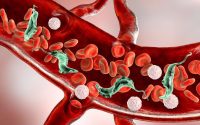Stunting cell ‘antennae’ could make cancer drugs work again
Scientists have uncovered a completely new way to make cancers sensitive to treatment—by targeting antenna-like structures on cells.
Their study found that drug-resistant cancer cells have more and longer antennae than those which are killed by treatment.
Blocking the growth of antennae reactivated a range of cancer treatments that had stopped working, the team at The Institute of Cancer Research, London, found.
The researchers identified changes in cellular antennae known as cilia in different types of cancer cells with resistance to various types of drugs. That suggests that targeting cilia could be a universal way to resensitise cancers to treatment.
The study is published today (Tuesday) in the journal Cell Reports, and was supported by funders including Sarcoma UK, the Wellcome Trust and Cancer Research UK.
Scientists at The Institute of Cancer Research (ICR) – a research institution and charity—studied cells from lung cancer and a soft-tissue cancer called sarcoma in the lab.
The researchers observed that cells that had become resistant to cancer drugs had more, longer cilia—tiny ‘antennae’ that help cells sense chemical signals.
They then blocked the growth of cilia in drug-resistant cancer cells, and found that their sensitivity to treatment had been restored.Exposure to drugs killed between 35 and 60 per cent of formerly resistant cancer cells—nearly doubling the effectiveness of cancer drugs.
For example, in lung cancer cells without cilia, only 39 per cent of cells survived treatment with a drug called erlotinib, compared with 72 per cent of cells that still had cilia.
Blocking important signalling molecules in cilia also restored cells’ response to cancer drugs. Lengthening cilia had the opposite effect, causing cells that previously had responded to treatment to develop resistance.
Cancer cells can evolve in many different ways to become resistant to treatment—for example, changing so that they no longer rely on the molecular weaknesses targeted by the drug.
The researchers believe that the role of cilia in drug resistance is largely linked to important cell signalling molecules they contain.
Next, they aim to study molecular networks in cilia, and the effect of changes in the length and stability of the structures, to better understand their role in cancer drug resistance.
Study leader Dr. Barbara Tanos, ICR Fellow in Cancer Therapeutics at The Institute of Cancer Research, London, said:
“We found that small, antenna-like cell structures called cilia play a key role as cancer cells develop resistance to treatment.
“We believe that cilia could help cancer cells become resistant to a wide range of drugs—and therefore that targeting cilia could be a universal way of stripping cancers of their defences.
“Next, we aim to explore changes to cilia in more depth, to build a more detailed picture of how they are linked to cancer drug resistance and how they might be targeted to restore sensitivity to treatment.”
Professor Paul Workman, Chief Executive of The Institute of Cancer Research, London, said:
“Combating drug resistance is one of the most important challenges in cancer research today. We urgently need a better understanding of the underlying biology that enables cancer cells to evolve and evade treatment.
Source: Read Full Article


